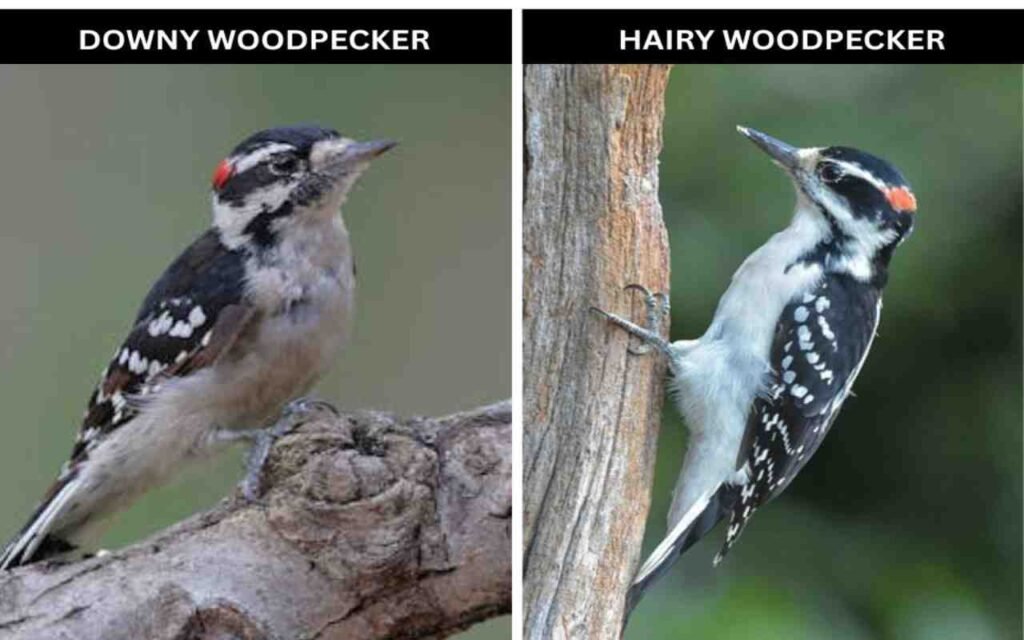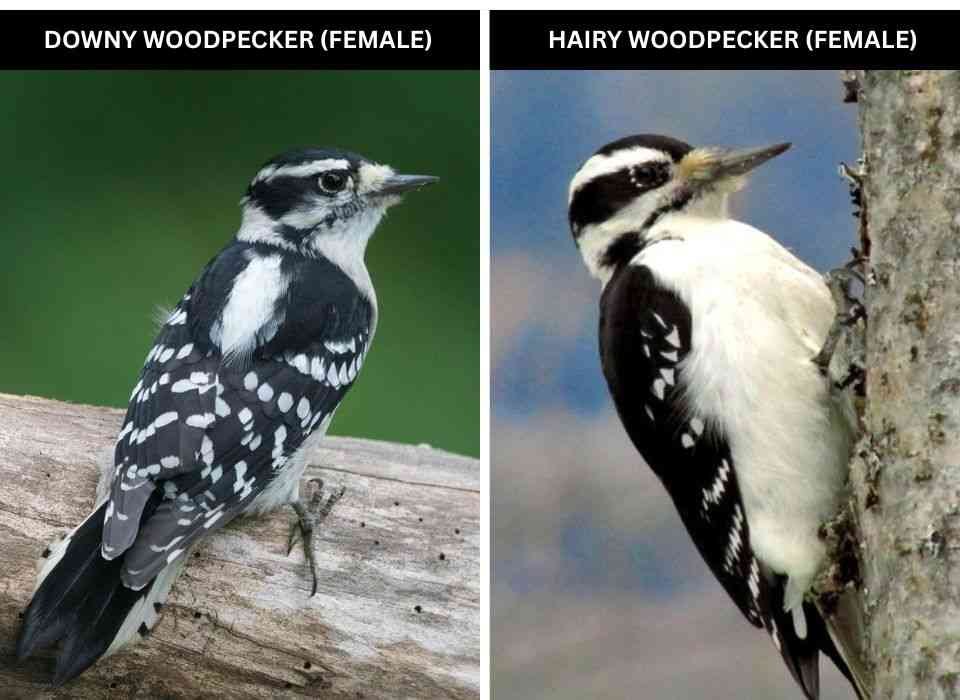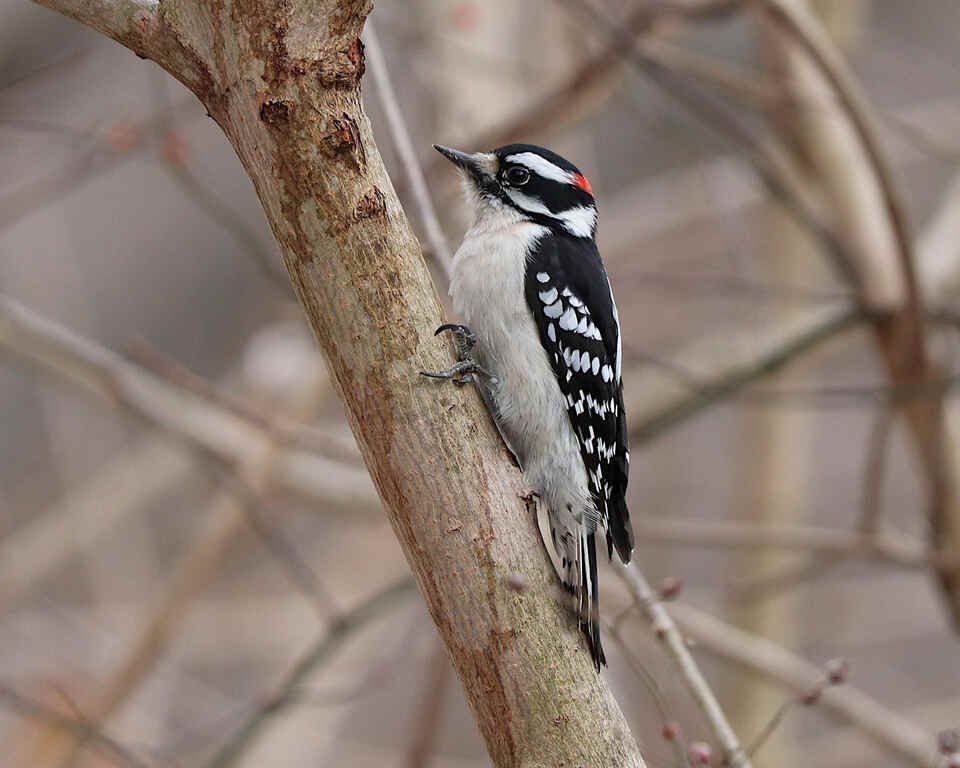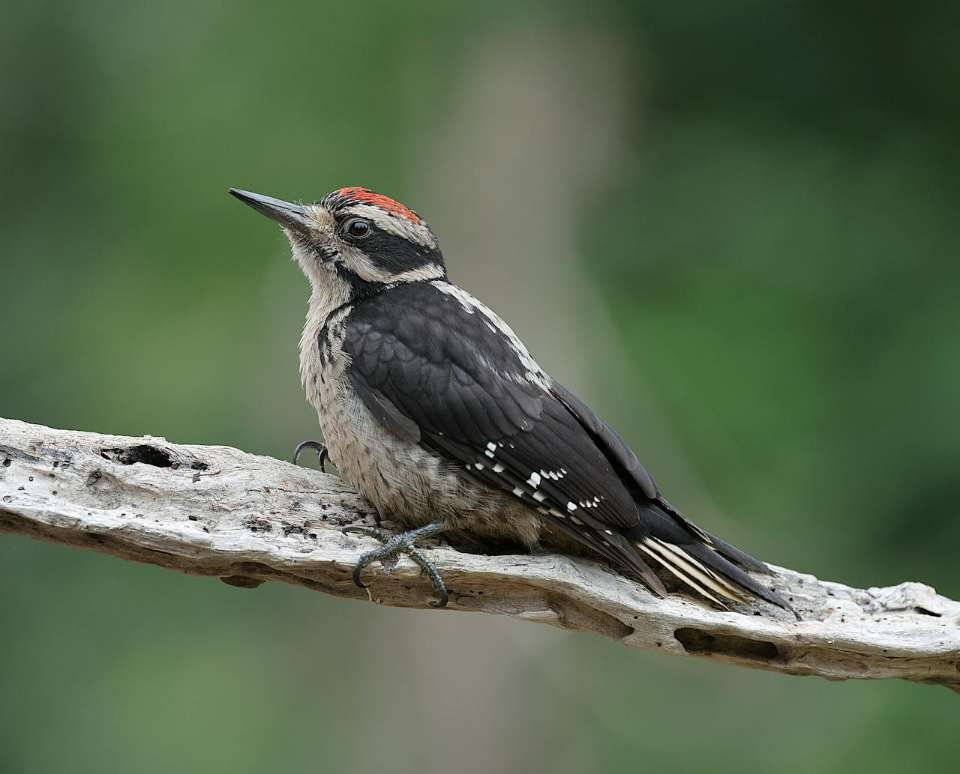If you’ve ever watched your backyard feeder and thought, “Wait… is that a Downy or a Hairy Woodpecker? 🤔” you’re not alone. This Downy vs Hairy Woodpecker comparison makes it easier to spot the differences, these tiny feathered drillers look almost identical, and even seasoned birders sometimes need a double-take. After countless mornings observing their taps, pecks, and hops, I’ve learned the tricks that make telling them apart a breeze.
Let’s break it down so next time one of these woodpeckers shows up, you can confidently call it by name. I’ll sprinkle in insider tips and funny anecdotes along the way, because identifying birds should feel like a story, not a textbook.
Size Matters: Downy vs Hairy
One of the easiest ways to separate these two, is by size. Seriously, it’s the first thing I check before squinting at the markings.
- Downy Woodpecker: Tiny little thing, usually about 6–7 inches long. Think the “fun-size” candy bar of the woodpecker world.
- Hairy Woodpecker: Bigger, around 9 inches long. Definitely more of a full-size candy bar, if you catch my drift.
So, if you’re trying to guess from afar and one of them looks like it’s on a diet, it’s probably a Downy. The Hairy? Bulkier, more like it’s hitting the bird gym. And yes, sometimes it’s tricky if they’re perched next to each other, but size is the first clue.
Pro Tip: Birds can look smaller or bigger depending on perspective, so always pair this clue with a look at other features.
Beak Check: Tiny vs Mighty
Okay, beak length is a game-changer. No, not for biting your sandwich, these birds use their beaks to chisel wood.
- Downy: Has a short, stubby beak. Perfect for pecking little bugs under bark.
- Hairy: Longer, more intimidating beak. It looks like it could drill through a birdhouse in seconds.
Next time you see one mid-peck, take a quick peek at the beak. If it seems almost the same length as its head, congratulations, it’s a Hairy. If it’s shorter, you’ve got a Downy.
Fun story: I once argued with my brother over a “Hairy” I spotted. Turns out it was a Downy pretending to be tough. Birds have a sense of humor too, apparently.
Wing Patterns and Spots
Now we get into the nitty-gritty of markings. Yes, those tiny dots and stripes matter more than you think.
- Downy Woodpecker: The outer tail feathers have black spots. Look closely, they’re like polka dots on a little black skirt.
- Hairy Woodpecker: Tail feathers are plain white, no polka dots here.
Also, both species have the signature black-and-white striped head, but males sport a red patch on the back of their heads. Don’t worry, females skip the red. FYI, spotting the difference in tail feathers is my personal trick. It’s subtle, but once you notice it, your bird ID game goes up a notch.
Back Stripes and Body Shape
It might feel like overkill to check every stripe, but trust me, patterns tell a story.
- Downy: Narrow black stripes down the back. Looks a bit dainty.
- Hairy: Wider black stripes, giving a more solid, “I mean business” vibe.
Also, Downys often look chunkier in the body relative to their small size, while Hairys appear more elongated. Your eyes will catch that subtle difference if you spend a few minutes watching them move around the tree.
I like to imagine the Downy as the “springy little acrobat” and the Hairy as the “professional lumberjack.” Totally makes backyard birdwatching more fun.
Sound Check: Drums and Calls
Bird identification isn’t just about looks. Their sounds can give away who’s who.
- Downy Woodpecker: High-pitched, fast drum. Sounds like a tiny machine gun. (Listen Now)
- Hairy Woodpecker: Slower, deeper drumming. More like a cautious hammer on a log. (Listen Now)
Also, their calls differ slightly:
- Downy: “Pik” or “pik-pik” sounds, kind of cute.
- Hairy: Louder, more rasping “peek” sound.
Pro Tip: If you can’t see them well, just listen. One quick drum session can solve the mystery.
Behavior and Habitat Differences
Even their habits help tell them apart. Watch closely.
- Downy: Often prefers smaller trees, shrubs, and feeders. They’re agile little buggers.
- Hairy: Goes for larger trees. Think tall oaks or maples, they want the big stuff.
Also, Downys are more likely to explore your backyard feeders, while Hairys might just peek in if there’s a giant insect banquet in your trees. I once had a Downy treat my sunflower seeds like gold; the Hairy just gave me the side-eye.
Seasonal Behavior and Nesting
Season can also hint at which bird you’re seeing.
- Downy: Nests in small cavities; sometimes even in ornamental garden trees.
- Hairy: Prefers bigger cavities in sturdy trees. You’ll rarely see them in small backyard setups.
During spring, keep an eye on the nesting behaviors, they can be quite entertaining. Downys may flit around constantly, while Hairys take their time and look more deliberate. Honestly, I enjoy watching them like a tiny reality TV show.
Male Downy Woodpecker pictured below:
Male Hairy Woodpecker pictured below:
Quick Reference Guide (Bird Nerd Cheat Sheet)
Sometimes you need a speedy way to ID them, especially if they’re zipping around.
| Feature | Downy | Hairy |
|---|---|---|
| Size | 6–7 inches | 9 inches |
| Beak | Short, stubby | Long, strong |
| Tail Feathers | Black spots | Plain white |
| Back Stripes | Narrow | Wide |
| Habitat | Smaller trees, feeders | Larger trees |
| Drum | Fast, high-pitched | Slow, deep |
| Male Head Red Patch | Yes | Yes |
| Female Head | None | None |
Keep this handy on your phone or print it out, I have mine taped to my birdwatching journal.
Common Mistakes to Avoid
I’ve seen people mix these up a ton of times, so here’s a friendly heads-up:
- Assuming size alone tells all. A Downy can look like a Hairy if it’s close to you, and perspective is tricky.
- Ignoring tail feather patterns. Those polka dots are life-savers.
- Thinking behavior is universal. Not every Hairy avoids feeders, and not every Downy flits like crazy. Birds have personalities, okay? 🙂
Tools and Tips for Backyard Birders
Want to make life easier? Here are some tricks that actually work:
- Binoculars: A must. Even budget ones make a huge difference.
- Bird ID Apps: Merlin Bird ID is free and surprisingly accurate.
- Field Guides: Paperback guides like National Geographic Birds of North America are great for offline use.
- Patience: Honestly, just chill. These birds do their thing, and you’ll catch the ID moment if you hang back.
Also, take notes. I keep a little journal of who visits when. Over time, it becomes like a little bird diary, and trust me, it’s oddly satisfying.
Why It Matters
You might wonder, “Why should I even care?” Well, knowing your Downy from your Hairy has a few perks:
- Helps with birdwatching journals or apps.
- Lets you accurately report sightings for citizen science.
- Gives bragging rights to friends who can’t tell the difference (FYI, I use this one all the time).
- Makes feeding and supporting your backyard birds more effective.
Honestly, it’s about the little victories in birdwatching. And yes, feeling like a bird detective is fun.
Final Thoughts
At the end of the day, Downy and Hairy Woodpeckers are both fascinating in their own right. Once you know to check size, beak length, tail spots, and drumming, you’ll rarely get confused again. And if you do, it’s okay, sometimes they’re just messing with us.
So next time you hear a high-pitched drum or see a tiny polka-dotted tail, you’ll smile and say, “Ah, that’s a Downy, not a Hairy.” And honestly, that little moment of recognition is what makes birdwatching so satisfying.
Happy birding 🙂 Keep your binoculars ready, your feeders stocked, and your sense of humor intact. These little woodpeckers may be tiny, but they sure know how to keep us entertained.





